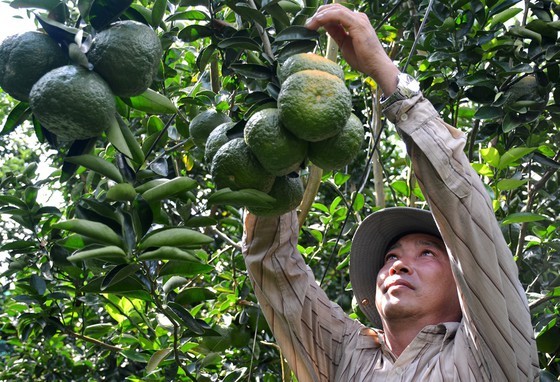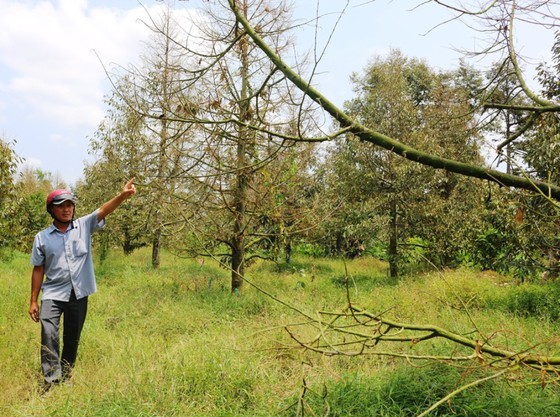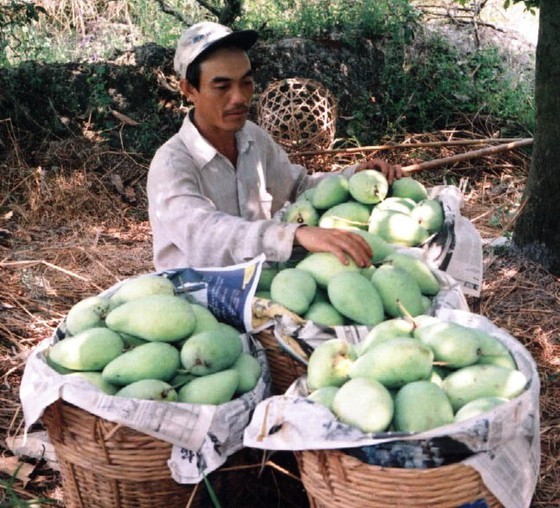
On September 17, the Ministry of Agriculture and Rural Development (MARD) coordinated with the People's Committee of Tien Giang Province to hold a seminar on measures to prevent saline intrusion and drought and the management of code issuance of fruit growing areas in the Mekong Delta in the period from 2020 to 2021.
The whole Mekong Delta region has about 362,000 hectares of fruit trees, accounting for more than 34 percent of the total area of fruit trees of the country. From 2013 up to now, the area of fruit trees has continuously increased with an average rate of 4.2 percent per year. In the past ten years, the country’s export turnover of vegetables and fruits has increased impressively. In 2019, the export value of vegetables and fruits reached US$3.7 billion.
However, the area of fruit trees is still scattered and small, making it difficult for investment in infrastructure, production cooperation, and quality control.
Noticeably, early dry season and prolonged saltwater intrusion and drought have caused disadvantages for fruit trees. In the Mekong Delta, more than 25,000 hectares of fruit trees were affected by saltwater intrusion and drought. Of these, about 11,181 hectares of fruit trees were completely lost.
The whole Mekong Delta region has about 362,000 hectares of fruit trees, accounting for more than 34 percent of the total area of fruit trees of the country. From 2013 up to now, the area of fruit trees has continuously increased with an average rate of 4.2 percent per year. In the past ten years, the country’s export turnover of vegetables and fruits has increased impressively. In 2019, the export value of vegetables and fruits reached US$3.7 billion.
However, the area of fruit trees is still scattered and small, making it difficult for investment in infrastructure, production cooperation, and quality control.
Noticeably, early dry season and prolonged saltwater intrusion and drought have caused disadvantages for fruit trees. In the Mekong Delta, more than 25,000 hectares of fruit trees were affected by saltwater intrusion and drought. Of these, about 11,181 hectares of fruit trees were completely lost.
 Many areas of durian trees in Tien Giang Province are destroyed because of saltwater intrusion and drought. (Photo: SGGP)
Many areas of durian trees in Tien Giang Province are destroyed because of saltwater intrusion and drought. (Photo: SGGP)
Facing the above situation, the MARD proposed provinces to promptly restore orchard, focus on desalination for the soil, use fresh water to water regularly to wash away the accumulated salt in the soil, put down lime for fruit trees to restore the roots and leaves, use bio-organic fertilizers, timely prevent pests and diseases, and increase the use of bio-products to water fruit trees.
Deputy Minister Le Quoc Doanh of the MARD noted that although the Mekong Delta is currently in flooding season, from now on, provinces need to prepare plans to cope with saltwater intrusion and drought in the dry season of 2020-2021 because according to the forecast, about 80,500 hectares of fruit trees in the Mekong Delta will likely be affected by saline intrusion and drought. Therefore, provinces need to make specific zoning for each type of fruit tree and each area, study the irrigation system, balance the sources of water and prioritize the care of fruits trees susceptible to salinity. They also need to develop protection plans for each fruit production area under the influence of different salinity levels and evaluate the adaptability of some fruit trees to each type of soils to have a long-term development orientation.
As for the issuance of the codes of growing areas and packing facilities, the Department of Plant Protection said that up to now, 998 growing-area codes have been granted in fastidious markets. Of which, the most granted codes are for the US with 471 codes, Australia and New Zealand with 393 codes, and South Korea with 199 codes. Besides, 47 codes of packing facilities for agricultural export products are granted to these markets. For the Chinese market, by August this year, 47 provinces have submitted requests and issued 1,735 growing-area codes. In the Mekong Delta alone, 628 growing-area codes and codes of 924 packing facilities have been issued for the Chinese market.
Deputy Minister Le Quoc Doanh of the MARD noted that although the Mekong Delta is currently in flooding season, from now on, provinces need to prepare plans to cope with saltwater intrusion and drought in the dry season of 2020-2021 because according to the forecast, about 80,500 hectares of fruit trees in the Mekong Delta will likely be affected by saline intrusion and drought. Therefore, provinces need to make specific zoning for each type of fruit tree and each area, study the irrigation system, balance the sources of water and prioritize the care of fruits trees susceptible to salinity. They also need to develop protection plans for each fruit production area under the influence of different salinity levels and evaluate the adaptability of some fruit trees to each type of soils to have a long-term development orientation.
As for the issuance of the codes of growing areas and packing facilities, the Department of Plant Protection said that up to now, 998 growing-area codes have been granted in fastidious markets. Of which, the most granted codes are for the US with 471 codes, Australia and New Zealand with 393 codes, and South Korea with 199 codes. Besides, 47 codes of packing facilities for agricultural export products are granted to these markets. For the Chinese market, by August this year, 47 provinces have submitted requests and issued 1,735 growing-area codes. In the Mekong Delta alone, 628 growing-area codes and codes of 924 packing facilities have been issued for the Chinese market.
 Authorities will strengthen management on the granted codes of growing areas and packing facilities. (Photo: SGGP)
Authorities will strengthen management on the granted codes of growing areas and packing facilities. (Photo: SGGP)
During the past time, the inspection and supervision of growing areas and packing facilities have been fully implemented, meeting the requirements. However, in June this year, the General Administration of Customs of the People’s Republic of China informed Vietnam’s plant quarantine agency that 220 batches of mangoes of about 3,300 tons out of a total of 750,000 tons of mangoes exported to China in 2019 and 2020, violated phytosanitary regulations for many different reasons. The Chinese authorities requested to suspend the export of mangoes from 12 growing areas and 18 related packing facilities to coordinate the investigation, propose solutions, and improve management. Of which, Tien Giang Province has the most suspended codes with 15 codes of packing facilities and growing areas, and An Giang Province has seven codes suspended.
According to the Department of Plant Protection, the percentage of codes of packing facilities and growing areas being suspended by China is not high, but this shows that the inspection and management of growing-area codes for export agricultural products need to be corrected in time. If authorities fail to inspect and supervise well, it will seriously affect the reputation of Vietnamese agricultural products in the international market, affecting the interests of farmers, or even losing the market, and being unable to export, if growing areas and packing facilities continuously violate the regulations of importing countries.
According to the Department of Plant Protection, the percentage of codes of packing facilities and growing areas being suspended by China is not high, but this shows that the inspection and management of growing-area codes for export agricultural products need to be corrected in time. If authorities fail to inspect and supervise well, it will seriously affect the reputation of Vietnamese agricultural products in the international market, affecting the interests of farmers, or even losing the market, and being unable to export, if growing areas and packing facilities continuously violate the regulations of importing countries.
























